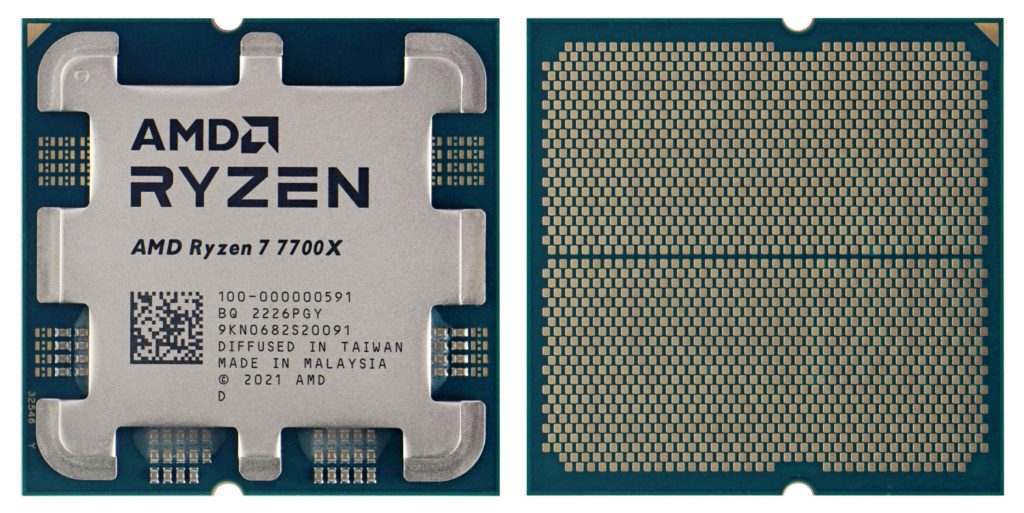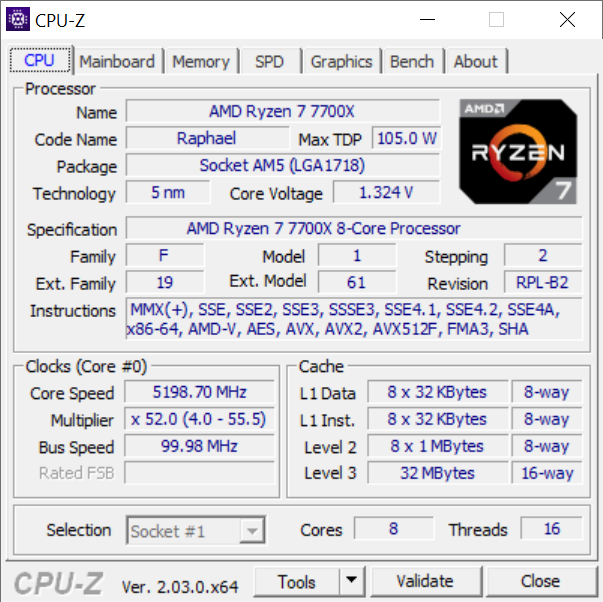AMD Ryzen 7 7700X in detail
It clearly outperformed its predecessors (including the R7 5800X) and also the Core i9-10900K, which has two more cores. But it can’t compare with the Core i7-13700K in heavy MT workloads, and that’s just a month after its release. In ST loads, however, it’s even performance-wise, as in games, where Ryzen 7 is more efficient. Whether the R7 7700X is worth more than the Ci7-13700K for similar money, however, you’ll have to judge for yourself.
AMD Ryzen 7 7700X in detail
It’s not often that after one month of a processor on the market, the ratings change significantly, but the Ryzen 7 7700X is exactly that case. In September last year, at the time of release, this processor was significantly more attractive than it is today, as it has (as of October 2022) a direct competitor – the Core i7-13700K.
AMD utilized the maximum capabilities of a single chiplet on the Ryzen 7 7700X. Not only by having all eight cores active, but they also achieve slightly higher clock speeds in long-term high load compared to the Ryzen 9s (7900X and 7950X). While the base clock speed is officially listed the same as for the R9 7950X, if you don’t lower the TDP (and leave the power limit unlocked, to the PPT limit), the all-core boost clock speeds are always significantly higher. In the case of the Ryzen 7 7700X they go above 5000 MHz. In games, or at lower loads, it’s even around 5300 MHz.
With increasing load, higher temperatures, and especially meeting PPT limits, clock speeds naturally drop, but the R7 7700X stays at 5.2GHz, which the R9 7900X doesn’t come close to matching. So you can be sure that the strain on one of the two chiplets/CCDs for the CPU cores is huge. While there is a second one on the CPU PCB, it is inactive and AMD does not use it for this model. And that’s perhaps a bit of a shame. If there were four cores in one and the remaining four in the other (so only one block of cores/CCX would be active across the chiplets/CCD), cooling would certainly be more efficient, albeit at the cost of splitting the L3 cache (and eventually lower performance, especially in games). However, the chosen scheme of one functional chiplet next to another non-functional (or deactivated) one is probably more advantageous from a production point of view. The disabled chiplet could theoretically be completely defective and unfit to even run four cores that would reach the high clock speeds that Ryzen 7 7700X “needs”. But most units don’t even have a second chiplet physically fitted.
The TDP of this processor is 105W with the PPT for boost clock speeds being 142W as for the previous generation Ryzen 5000 (Vermeer). AMD officially lists the single-core boost at 5.4GHz, but unofficially it can be roughly 100MHz higher as long as the temperature doesn’t exceed 70°C. I guess everything has been said about the basics, for more detailed parameters you can go to the table below.
| Manufacturer | AMD | Intel | |
| Line | Ryzen 7 | Core i7 | |
| SKU | 7700X | 13700K | |
| Codename | Raphael | Raptor Lake | |
| CPU microarchitecture | Zen 4 | Golden Cove (P) + Gracemont (E) | |
| Manufacturing node | 5 nm + 6 nm | 7 nm („Intel 7 Ultra“) | |
| Socket | AM5 | LGA 1700 | |
| Launch date | 09/27/2022 | 10/20/2022 | |
| Launch price | 399 USD | 409 USD | |
| Core count | 8 | 8+8 | |
| Thread count | 16 | 24 | |
| Base frequency | 4.5 GHz | 3.4 GHz (P)/2.5 GHz (E) | |
| Max. Boost (1 core) | 5,4 GHz (unofficially 5,51 GHz) | 5.4 GHz (P)/4.2 GHz (E) | |
| Max. boost (all-core) | N/A | 5.3 GHz (P)/4.2 GHz (E) | |
| Typ boostu | PB 2.0 | TBM 3.0 | |
| L1i cache | 32 kB/core | 32 kB/core (P), 64 kB/core (E) | |
| L1d cache | 32 kB/core | 48 kB/core (P), 32 kB/core (E) | |
| L2 cache | 1 MB/core | 2 MB/core (P), 2× 4 MB/4 cores (E) | |
| L3 cache | 1× 32 MB | 1× 30 MB | |
| TDP | 105 W | 125 W | |
| Max. power draw during boost | 142 W (PPT) | 253 W (PL2) | |
| Overclocking support | Yes | Yes | |
| Memory (RAM) support | DDR5-5200 | DDR5-5600/DDR4-3200 | |
| Memory channel count | 2× 64 bit | 2× 64 bit | |
| RAM bandwidth | 83,2 GB/s | 89,6 GB/s/51,2 GB/s | |
| ECC RAM support | Yes (depends on motherboard support) | Yes (with vPro/W680) | |
| PCI Express support | 5.0 | 5.0/4.0 | |
| PCI Express lanes | ×16 + ×4 + ×4 | ×16 (5.0) + ×4 (4.0) | |
| Chipset downlink | PCIe 4.0 ×4 | DMI 4.0 ×8 | |
| Chipset downlink bandwidth | 8,0 GB/s duplex | 16.0 GB/s duplex | |
| BCLK | 100 MHz | 100 MHz | |
| Die size | 66,3 mm² + 118 mm² | ~257 mm² | |
| Transistor count | 6,57 + 3,37 bn. | ? bn. | |
| TIM used under IHS | Solder | Solder | |
| Boxed cooler in package | No | No | |
| Instruction set extensions | SSE4.2, AVX2, FMA, SHA, VAES (256-bit), AVX-512, VNNI | SSE4.2, AVX2, FMA, SHA, VNNI (256-bit), GNA 3.0, VAES (256-bit), vPro | |
| Virtualization | AMD-V, IOMMU, NPT | VT-x, VT-d, EPT | |
| Integrated GPU | AMD Radeon | UHD 770 | |
| GPU architecture | RDNA 2 | Xe LP (Gen. 12) | |
| GPU: shader count | 128 | 256 | |
| GPU: TMU count | 8 | 16 | |
| GPU: ROP count | 4 | 8 | |
| GPU frequency | 400–2200 MHz | 300–1600 MHz | |
| Display outputs | DP 2.0, HDMI 2.1 | DP 1.4a, HDMI 2.1 | |
| Max. resolution | 3840 × 2160 px (60 Hz) | 7680 × 4320 (60 Hz) | |
| HW video encode | HEVC, VP9 | HEVC, VP9 | |
| HW video decode | AV1, HEVC, VP9 | AV1, HEVC, VP9 |
- Contents
- AMD Ryzen 7 7700X in detail
- Methodology: performance tests
- Methodology: how we measure power draw
- Methodology: temperature and clock speed tests
- Test setup
- 3DMark
- Assassin’s Creed: Valhalla
- Borderlands 3
- Counter-Strike: GO
- Cyberpunk 2077
- DOOM Eternal
- F1 2020
- Metro Exodus
- Microsoft Flight Simulator
- Shadow of the Tomb Raider
- Total War Saga: Troy
- Overall gaming performance
- Gaming performance per euro
- PCMark and Geekbench
- Web performance
- 3D rendering: Cinebench, Blender, ...
- Video 1/2: Adobe Premiere Pro
- Video 2/2: DaVinci Resolve Studio
- Graphics effects: Adobe After Effects
- Video encoding
- Audio encoding
- Broadcasting (OBS and Xsplit)
- Fotky 1/2: Adobe Photoshop and Lightroom
- Photos 2/2: Affinity Photo, Topaz Labs AI Apps, ZPS X, ...
- (De)compression
- (De)encryption
- Numerical computing
- Simulations
- Memory and cache tests
- Processor power draw curve
- Average processor power draw
- Performance per watt
- Achieved CPU clock speed
- CPU temperature
- Conclusion










